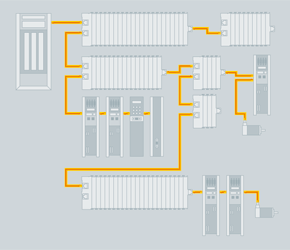Topology
![]() Ethernet is a large, diverse family of frame-based computer networking technologies that operate at many speeds for local area networks (LANs). physical layers, EtherCAT
Ethernet is a large, diverse family of frame-based computer networking technologies that operate at many speeds for local area networks (LANs). physical layers, EtherCAT![]() Ethernet ofr Control Automation Technology.
EtherCAT® is an open, high-performance Ethernet-based fieldbus system.
The development goal of EtherCAT is to apply Ethernet to automation applications which require short data update times (also called cycle times) with low communication jitter (for synchronization purposes) and low hardware costs. slave controllers close an open port automatically and return the Ethernet frame
Ethernet ofr Control Automation Technology.
EtherCAT® is an open, high-performance Ethernet-based fieldbus system.
The development goal of EtherCAT is to apply Ethernet to automation applications which require short data update times (also called cycle times) with low communication jitter (for synchronization purposes) and low hardware costs. slave controllers close an open port automatically and return the Ethernet frame![]() In networking dialect, a message is called a frame. if no downstream device is detected.
In networking dialect, a message is called a frame. if no downstream device is detected.
- Slave devices can have several ports.
- Using these features, EtherCAT can support almost any physical topology (e.g., line, tree, or star).
- The bus or line structure known from the fieldbuses
 An industrial network system for real-time distributed control (e.g., CAN or PROFIBUS, Sercos®).
It is a way of connecting instruments in a plant design. is then available for Ethernet.
An industrial network system for real-time distributed control (e.g., CAN or PROFIBUS, Sercos®).
It is a way of connecting instruments in a plant design. is then available for Ethernet.
- The bus or line structure known from the fieldbuses
The combination of line and branches or stubs is also possible.
- Any EtherCAT device with three or more ports can act as a junction; no additional switches are required.
- The classic switch-based Ethernet star topology can be used either with switches configured to forward traffic directly
 The orientation components of a vector in space. between ports, or with special slave devices.
The orientation components of a vector in space. between ports, or with special slave devices. - The switches are then located between the network master and the slave devices.
The special slave device assembly (i.e., standard slave devices don't have a MAC address![]() A Media Access Control (MAC) address is a quasi-unique identifier assigned to most network adapters or network interface cards (NICs) by the manufacturer for identification.
If assigned by the manufacturer, a MAC address usually encodes the manufacturer's registered identification number.) attached to one switch port together forms an EtherCATsegment. This is either addressed via its MAC address or via port-based VLANs.
A Media Access Control (MAC) address is a quasi-unique identifier assigned to most network adapters or network interface cards (NICs) by the manufacturer for identification.
If assigned by the manufacturer, a MAC address usually encodes the manufacturer's registered identification number.) attached to one switch port together forms an EtherCATsegment. This is either addressed via its MAC address or via port-based VLANs.
- Since the 100BASE-TX Ethernet physical layer is used, the distance between any two nodes can be up to a maximum of 100 m (300 ft).
- Up to 65535 devices can be connected per segment.
- If an EtherCAT network is wired in ring configuration (requiring two ports on the master device), it can provide cable redundancy.
Figure 1: Flexible Topology: Line, Tree, or Star
- KAS
 Kollmorgen Automation Suite controllers support line, tree, and star topologies.
Kollmorgen Automation Suite controllers support line, tree, and star topologies. - Ring topologies and cable redundancy is not supported because the KAS controllers have a singe EtherCAT port.







